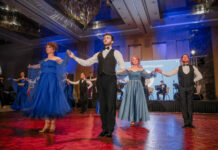BY RAYA ABBASOVA
There is no need to write an incredibly long and impressive list of all the titles, awards and merits of the outstanding Azerbaijani artist Tahir Salakhov. His personal essence and professional interests are organically intertwined – being wise in life, he is wise in work too; being courageous in creative decisions, he is always ready to listen, to understand and to lend a helping hand in order to prevent injustice in everyday life. Tahir Salakhov is famous, and he has won this fame and recognition with his successful and multifaceted activities as an artist, scene designer, teacher, and a major public figure.
Question: Nowadays people often and quite convincingly speak about human ability to predict the future.
Is your monumental painting, For You, Humanity!, part of such a prediction or a result of, let us say, information leakage?
Answer: I believe you have this question because the date of the presentation of this painting was April 12, 1961 and coincided with the first manned spaceflight. I will be frank with you, I did not receive any orders or contracts for this painting. And, as you understand, a leakage of information on such an issue could not have happened. On that day, the country celebrated the annual Day of the Artist, and it was just a lucky coincidence. Besides, humans had always dreamed of flying, and flight was quite often equaled to free-floating thoughts, unshackled creative energy and fantasy, though sometimes, the idea of flying contained some wise message. It is hard for me to say whether I had some kind of presentiment or premonition. Maybe… But does it matter? The most important thing was that the painting evoked huge public interest, which was multiplied by the news about the flight of Yuri Gagarin, the first human in outer space. Of course, I was happy with such a coincidence. However, I worried about the painting many times later. But, time puts everything in its place. In 2008, For You, Humanity! was displayed at the Venice Biennale, marking the start of its space odyssey.
Q.: When you headed the USSR Union of Artists, you supervised, among other activities, the cultural relations of the Soviet Union with foreign countries. How wide was the cooperation of the USSR with the international community in the cultural sphere?
A.: It was the period of the Cold War, which was not an easy period. Cultural contacts were mainly limited to socialist countries. However, the management of the Union of Artists of the USSR did everything possible to enable interaction with artists from different countries, despite all the obstacles. So, in the late 80s – early 90s of the last century, we organized a number of large-scale projects in Moscow and Leningrad (now St. Petersburg), including personal exhibitions of such famous Western artists as Günther Uecker, Robert Rauschenberg, Gilbert and George, Jean Tengli, Giorgio Morandi, Rufino Tamayo, James Rosenquist, Jannis Kounellis and many others.
Q.: In addition to personal exhibitions, you came up with the idea of thematic art exhibitions, such as Twelve European Artists from the Lenz Schoenberg collection, Forty Artists of New York, French Academy of Arts and others …
A.: These projects implemented in Moscow, St. Petersburg and other cities aroused wide interest amongst the public. They also resulted in creative exchange. Many exhibitions of Soviet artists were organized abroad as a response to our initiatives. It was not easy to push such projects, but the efforts were worth it, because such exhibitions opened up new perspectives and helped us to make new acquaintances, which very often became friends after some time. So, we were friends with the famous American artist Robert Rauschenberg for many years. Robert was the one who invited me to the opening of his personal exhibition in Berlin, where I witnessed a historic event – the fall of the Berlin Wall. In my personal archive, I have a photo which captures the moment when I passed through the breach in the wall from East Berlin to West. When Robert was already very sick, my daughter Aidan, while in Miami, visited him and helped us to speak over phone for the last time. My English is poor, Robert did not speak Russian, but we talked and talked … expressed our respect for each other, discussed our work in art… This talented painter unfortunately passed away in May 2008 …
Q.: I know that you have a letter of gratitude from the famous painter Francis Bacon. Critics say that the paintings of Bacon are ‘nourished’ by human pain and suffering. Even the Iron Lady Margaret Thatcher called him “a man who paints those dreadful pictures.”
A.: There were a wide variety of opinions and views on Francis Bacon’s works of art, but he did not abandon his artistic principles under any circumstances. As a result of such a principled approach, he was ranked among the greatest British masters of the 20th century in the late period of his life and career. Nowadays, Bacon’s paintings are highly valued, and some of his pieces are even considered among the most expensive and sought-after works of art of our time.
In the early 80s, as one of the managers of the USSR Union of Artists, I managed to bring Francis Bacon’s exhibition to Moscow. Bacon could not come, but we solved all the organizational issues with the British Embassy. Later, I received a letter from him where he thanked me for the opportunity to exhibit his paintings in Moscow. After some time, we were able to meet in person, but in London. At one reception in honor of Margaret Thatcher, she asked me a question:
– Mr. Salakhov, what British artists do you know?
– In 1987 we held an exhibition of British artists such as Francis Bacon and Gilbert and George in Moscow on my initiative, I replied.
– Well, I do not question the attitude towards modern art in your country then, she said with satisfaction.
I believe this short dialogue shows the high recognition and respect for the talent of this artist.
Q.: In 2019, we celebrate the 110th anniversary of famous Azerbaijani painter Sattar Bahlulzade. Could you tell our readers about your last meeting with the artist?
A.: In 1973, Sattar fell seriously ill and needed to go to Moscow for urgent medical treatment. However, it was quite expensive, and when I came to visit him he confessed that he could not go because could not afford it. I promised him I’d solve the problem, having no idea how to find such a big sum in a short time. However, we found the solution – we urgently decided to sell his works of art and had the required amount of money by evening. That was his second and last trip to Moscow.
Q.: The outstanding politician of the XX century Heydar Aliyev, expressed his attitude towards your work with the approximate quotation, “Tahir is a member of a number of world academies. Are there any academies where you have not got recognition?”
A.: It takes a back seat to the personality of Heydar Aliyev himself. I will tell you the episode, though there were many. In 1981, I organized a Presidium of the USSR Academy of Arts, Ministry of Culture and the Union of Artists in Baku with the presentation of diploma works by graduates of USSR art schools. Outstanding artists, rectors of art universities, representatives of the creative elite from all over the Soviet Union came to Baku. Heydar Aliyev attended a huge exhibition organized on the boulevard and later delivered a speech at an extended meeting of the USSR Presidium of the Academy of Arts and the Scientific and Methodological Council for Art Education in the Azerbaijan Sciences Academy. A born speaker, he professionally assessed the works of the artists and identified the main tasks of art at that time. I remember with what pride and knowledge of the issue Heydar Aliyev spoke about the originality and multifaceted history of Azerbaijani artistic culture. Being a worthy son of his country, he showed the highest tact and noted that every representative of the fraternal nations could also tell the audience about the successes of his region. Heydar Aliyev’s speech at the forum was published in the Bakinskiy Rabochiy (Baku Worker) newspaper, which I still keep in my archives. These memories are dear to me. And I was very proud and happy when Azerbaijani President Ilham Aliyev presented me with the highest award, the Order of Heydar Aliyev, on my 80th birthday.
Q.: “Our Tahir is Tahir of the whole world.” This is a quote from a magazine and there are many facts that confirm it. For example, your Portrait of Gara Garayev was a part of the Russia! exhibition dedicated to the 60th anniversary of the UN at the Solomon R. Guggenheim Museum in New York, USA. The exhibition was inaugurated by Russian President Vladimir Putin, which shows the significance of the event.
A.: The exhibition presented the 270 great masterpieces of Russian art from the 14th century to the present–and it was really an honor that one of them was mine. The portrait of Gara Garayev was exhibited with the masterpieces of Andrei Rublev, Ilya Repin, Vasily Perov, Vasily Surikov, Mikhail Vrubel, Kazimir Malevich and other world-known artists. According to the press and art historians, The Portrait of Gara Garayev created a furor and “was a discovery for the US.”
When I was young, we got a lot of information about ourselves by chance. I remember that in 1962 I met one of my friends in the city center of Baku and he congratulated me on something that I did not understand. It turned out that seven of my paintings were exhibited at the Venice Biennale among the paintings of the classics of Soviet art. Such an attention is really priceless.
Q.: In 1963 the Faculty of Fine Arts was opened at the Azerbaijan State University of Culture and Arts on your initiative.
A.: Yes, and I attended the first entrance exams, when 15 students entered the faculty. Over the next ten years, I became an assistant professor, and then professor. I am proud of these titles, because they had to be approved in Moscow at that time and it was not easy to get them. One hundred-fifty artists were born before my eyes during these ten years. Then I continued my pedagogical activity at Surikov Moscow State Academic Art Institute, where I headed the Painting and Composition Department for some period of time. Today it is a great pleasure for me to communicate with my former students and see their successes.
Q.: What did you pass on to your students?
A.: Understanding and seeing the volumes, proportions, the golden ration… I always urge young artists to pay attention to the details. It is not enough to draw the eyes of David; an artist has to look into them. You can portray his muscles, but you should know anatomy to make it realistic. The school of painters of the Renaissance was based on this. In teaching it is important for me not to impose my vision, but to see the individuality of each student, to give him opportunity to choose. Although, knowledge of the classical laws of artistic creativity is obligatory.
I believe that I can say that I managed to achieve a lot in my profession. However, I always remember that I started my path by drawing on the asphalt of the squares intended for mass festivities and preparing posters in Highland Park in Baku. It was in 1944 – the period of war, and there was a curfew in the city. Sometimes I had to work at night and night patrols saw me, but, convinced of my peaceful purposes, they even treated me to some food.
I keep my memories carefully. They are a part of my life that helped me learn how to overcome difficult situations, and appreciate what heaven gives. Fame does not come immediately – you have to win it, to earn it. It is important to believe in yourself and your future and constantly work on yourself. It is important to be objective and try not to overestimate your talent. Our life and profession have their own laws, and we have to learn and follow them.



















